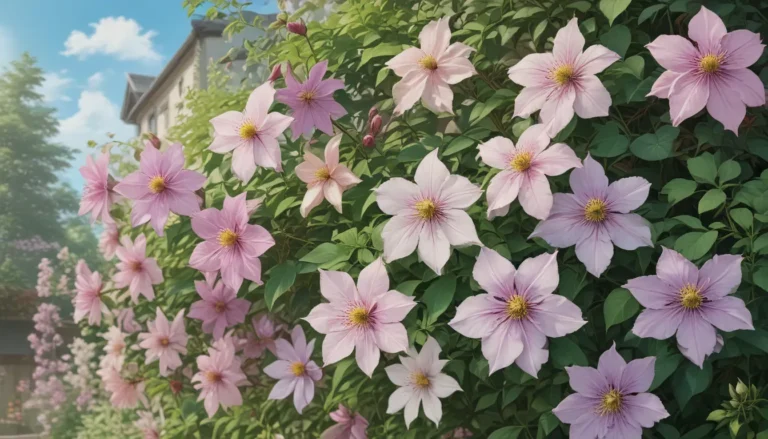Comprehensive Guide to Growing Tree Peonies

Peonies, regardless of their type – herbaceous, woody, or intersectional, have a special place in the hearts of gardeners all around the world. However, it’s the tree peonies that seem to stand out with their slow-growing perennial shrubs and stunning single or double-petaled flowers that signal the arrival of spring.
In this extensive guide, we’ll explore everything you need to know about tree peonies – from their cultivation and history to how to grow, maintain, and propagate them successfully. Let’s dive in and discover the joy of growing these unique ornamental plants.
What Are Tree Peonies?
Tree peonies belong to the Paeonia genus, encompassing both herbaceous and shrubby perennials prized for their ornamental flowers. Originating in China 1,500 years ago, these woody-stemmed peonies are mainly derived from P. x suffruticosa and P. delavayi species.
While there’s some debate among growers about the proper classification, understanding hybrid groups such as P. x suffruticosa, P. x rockii, and lutea hybrids provides insight into the unique attributes of each type. These groups portray a diverse array of colors, sizes, and fragrances, making them a delightful addition to any garden.
Cultivation and History
Historically, tree peonies played a significant role in both Chinese medicine and ornamental gardens. Cultivated over 1,500 years ago in China, these plants were later introduced to Europe and made their way into modern hybrid varieties we cherish today.
Propagation methods for tree peonies include seed germination, grafted rootstock, division, and branch layering. Each approach offers different advantages and challenges, allowing gardeners to experiment and find the best method for their needs.
How to Grow Tree Peonies
The growth of tree peonies follows a natural progression: first year sleep, second year creep, and third year leap. Patience is key when cultivating these plants, as they prioritize root development before producing flowers.
Selecting the right cultivar, ensuring proper sunlight exposure, providing well-draining soil, and feeding with organic compost are essential steps in fostering healthy growth. Moreover, tree peonies do not usually require staking unless exposed to strong winds.
Maintaining optimal soil moisture, avoiding overwatering, and protecting plants from extreme cold are critical aspects of successful tree peony cultivation. Additionally, adhering to a consistent fertilization schedule aids in promoting root growth and ensuring robust blooming seasons.
Growing Tips
- Choose a location with morning sun and dappled afternoon shade.
- Plant in rich, well-draining soil with a pH of 6.5 to 7.5.
- For grafted tree peonies, plant the graft point two to three inches below the soil line.
- Water established plants only when the top four inches of soil are dry, and avoid overwatering.
Pruning and Maintenance
Pruning tree peonies is a straightforward process that involves removing dead, weak, or unproductive growth annually. Proper pruning techniques in early spring help maintain plant health and structure while encouraging new growth and flowering.
Regular inspections for suckering, herbaceous rootstock growth, and disease symptoms are essential for maintaining tree peonies’ aesthetic appeal and vitality. Utilizing broad-spectrum fungicides, proper watering, and environmental management aid in disease prevention and pest control.
Cultivars to Select
Choosing the right cultivar of tree peony is crucial for achieving desired flower colors, sizes, and fragrances. Options such as ‘Godaishu,’ ‘Hana Kisoi,’ ‘High Noon,’ ‘Manchurian Promise,’ and ‘Shimadaijin’ present varying characteristics suitable for diverse garden aesthetics.
Each cultivar offers distinct features and growth habits, making them ideal for different garden themes and design preferences. Understanding cultivar attributes provides valuable insights for selecting the perfect tree peonies for your landscape.
Managing Pests and Disease
While tree peonies are generally resilient to diseases and pests, vigilance is crucial to prevent and manage common issues. Addressing nematodes, foliar infections, stem and root rot, and mildew promptly using appropriate treatments, fungicides, and hygiene practices optimizes plant health and longevity.
Proactive steps such as removing infected plant parts, maintaining soil health, providing adequate ventilation, and monitoring plant conditions help mitigate disease and pest risks. Implementing preventative measures and seeking professional advice when necessary ensure a thriving garden environment for tree peonies.
Best Uses
Tree peonies serve as versatile garden additions, offering vibrant spring blooms, structural interest, and winter appeal. Ideal for cottage, Japanese, and Chinese gardens, tree peonies suit various landscape styles, emphasizing aesthetic beauty and seasonal charm.
Whether as standalone specimens, companions for bulbs and perennials, or focal points in garden beds, tree peonies elevate outdoor spaces with their elegant foliage and show-stopping blooms. Their versatility, longevity, and adaptability make them prized ornamental plants suitable for diverse garden settings.
Conclusion
In conclusion, cultivating and maintaining tree peonies requires careful attention to detail, patience, and dedication. By understanding their unique attributes, selecting suitable cultivars, and following best practices for care and maintenance, gardeners can enjoy the beauty and resilience of these charming shrubs.
Tree peonies symbolize the essence of spring, offering a harmonious blend of elegance, fragrance, and color to outdoor spaces. With proper cultivation, disease management, and pest control, tree peonies can thrive for generations, enriching gardens with their timeless beauty and enduring charm.
Are you ready to embark on a journey of tree peony cultivation and discover the wonders of these captivating plants? Share your experiences, tips, and favorite cultivars in the comments below, and let the enchantment of tree peonies inspire your gardening adventures!





